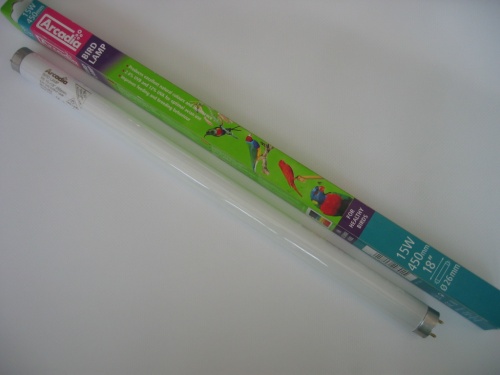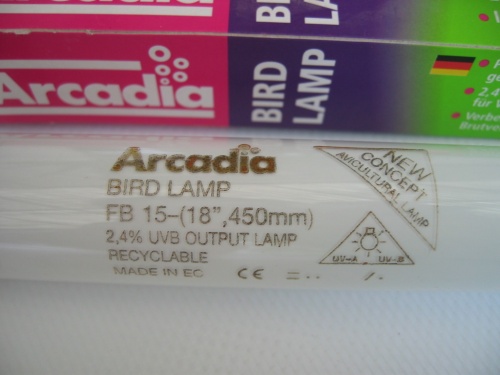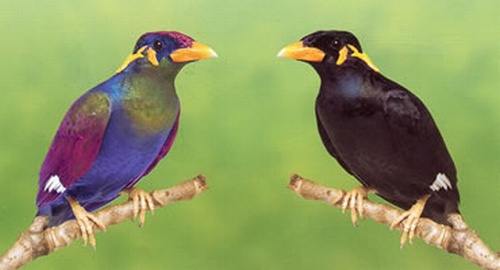


Ornibird.com, le spécialiste pour vos Oiseaux et Animaux !
Ornibird.com, le spécialiste pour vos Oiseaux et Animaux !



(€21.35 pièce)
Why is a lamp designed specifically for birds?
Unlike humans, birds see the ultraviolet light part of the spectrum of the natural light of the day. The bird need the UV for their reproduction and feeding – a bird without UV, it is a bit like a man who sees only in black and white, or even worse.



Why is a lamp designed specifically for birds?
Unlike humans, birds see the ultraviolet light part of the spectrum of the natural light of the day. The bird need the UV for their reproduction and feeding – a bird without UV, it is a bit like a man who sees only in black and white, or even worse.
Even in black and white, the man is able to recognize the sex of its congeners. However, some species of birds require UV to differentiate the males from the females.
If the bird lives in a house, it is necessary to provide an ultraviolet light. A domestic lighting normal is not enough. In addition, most of the lighting for domestic change the natural colours of the bird. The lamp for birds Arcadia has been specifically designed to provide the level of UV correct to showcase its true colours.


What is a light spectrum of full?
By full spectrum, we mean a balanced light over the entire spectrum, including the segment of ultra-violet light. Most of the fluorescent tubes, three bands present include the three peaks of energy that match the three colors that your eyes perceive. Thus, for the human eye, the light useful of the tube is maximized, and thus seems very bright. These peaks are not necessarily perceived by the eye of the bird, which means, of course, the absence of UV. The real tube is a full spectrum offers a spectrum balanced, because the spaces between the spikes fluorescent three stripes are filled in by a light emitted from a mixture of halophosphate. In addition, phosphors that emit UV have been added and these represent approximately 15 % of the lumen of the tube. The proportion of UVA and UVB in these phosphors is respectively of 12 and 2.4 %.
The overall color of the light tube should be as close as possible to that of natural sunlight, which is 5,500 K. 5 600 K, the lamp Arcadia is very close to this value. For birds, the color temperature must not exceed 5 800 K. A spectrum with too much blue produces mainly birds of the female sex. For this reason, it is necessary to avoid use of the lamps in the aquarium for the birds. A spectrum of light complete also needs to accurately reproduce colors. This is what the lamp Arcadia offers, with a specification Class 1A.
The importance of a spectrum of light, complete
A poor quality of light acts on the cycle oculoendocrinien (light to the pituitary and the pineal gland), and this severely affects the health of the bird. A light misdirected can be a source of agitation, pulling feathers, general weakness, behavioral problems and metabolic disorders.
Synthesis of vitamin D3
Vitamin D3 is needed by birds for normal growth of their bones. Many animals can synthesize vitamin D3 from the light of the day through their skin. More exactly, it's the UVB rays of the spectrum that allow this synthesis. Birds can not synthesize vitamin D3 in the same way because their skin is covered with feathers. In most birds, blood flow brings the provitamin D3 to the gland uropygienne, which concentrates in the glandular secretions. These are then applied to the feathers during lubrication and are therefore exposed to UVB. The bird swallows subsequently the material is exposed to the UV, when it is smooth again, and the oil enters the body in the form of vitamin D. The liver and the kidney the then transformed into vitamin D3.

The extent to which the vision of the bird differ from that of man ?
The retina of the eye contains cones, which, when stimulated by wavelengths of light different, and transmit information about color to the brain. In humans, there are three types of cones that allow us to perceive three primary colors : red, green, and blue. This is what we call a vision trichromatic. The combination of these colors allows us to perceive literally thousands of different colors. Birds have a fourth cone type, which is sensitive to ultraviolet light, and thus, they can perceive four primary colors, the additional color being that of the UV. This is what we call a vision tétrachromatique. In humans, the ultraviolet light cannot pass through the lens, but the bird does not have this problem. The latest research has shown that some birds can see up to five primary colors (that is to say, have a vision pentachromatique) and are able to tell the difference between two wavelengths of UV are different.
The effect of the light of day on birds
Birds perceive light in two ways. First of all, by the eye. The retina of the eye is capable of transmitting information on the intensity, color composition, and the polarization (direction) of the light. This information travels in two directions : to the brain via the optic nerve and also to the pituitary gland by a journey special. The birds also have a different way of perceiving light, a special gland which surrounds the eye, called the Harderian gland. This gland measures the duration during which a bird receives light, called photoperiod, and it transmits this information to the pineal gland. The pituitary gland and the pineal gland are both regulators of the endocrine system and their effect on the whole metabolism of the bird. To ensure that the health of the bird is optimal, you must turn on your lights an hour after sunrise and turn it off an hour before the night. For this, it is recommended to use a timer. It thus preserves the annual natural cycle of the light of the day as well as the natural conditions corresponding to the reproductive cycle of the bird and, therefore, the cycle of development of feathers. The oiseliers know that it is possible to induce certain behaviors by extending the photoperiod from 14 to 16 hours. In most cases, this should be done gradually. If this method fails, a sudden increase sometimes produces the desired effects.
The importance of UV for the bird
A bird living in a house can be a miss UV. In fact, the windows filter out the ultraviolet rays of the light that comes from the outside. In addition, the sources of lighting household normal does not emit UV. It is therefore necessary to add an ultraviolet light, and that is why we created the lamp for birds Arcadia. Bird feathers reflect ultraviolet light. The reflection of the plumage plays a key role when birds choose their partners during the mating. The presence of UV, thus promoting reproduction. Birds such as mynahs, that the human eye perceives as black, appear colored to other birds. This is the same case for the white birds. The perception of UV light plays a significant role in the selection of the food. The ripe fruits and berries appear as a different color for a bird. The pollination requires the reflection of the UV rays that help the bird to land on the flower. What a bird sees affects its appetite. The reds are redder and greens are greener thanks to the UV light. A bird that refuses to feed needs UV to stimulate her appetite.
The UV orientation
The perception of UV is used by birds for orientation. Thanks to the polarization of the light of the day, a bird is able to know where the light comes. This allows him to move correctly for its volume
Data sheet
Specific References
No customer reviews for the moment.

Why is a lamp designed specifically for birds?
Unlike humans, birds see the ultraviolet light part of the spectrum of the natural light of the day. The bird need the UV for their reproduction and feeding – a bird without UV, it is a bit like a man who sees only in black and white, or even worse.

(€21.35 pièce)
check_circle
check_circle








